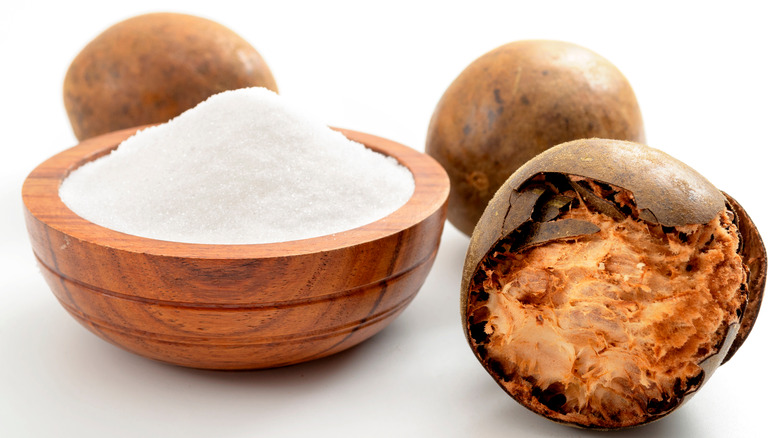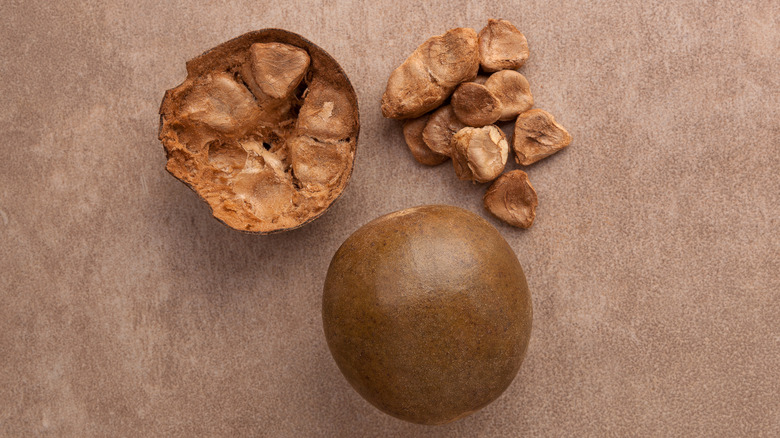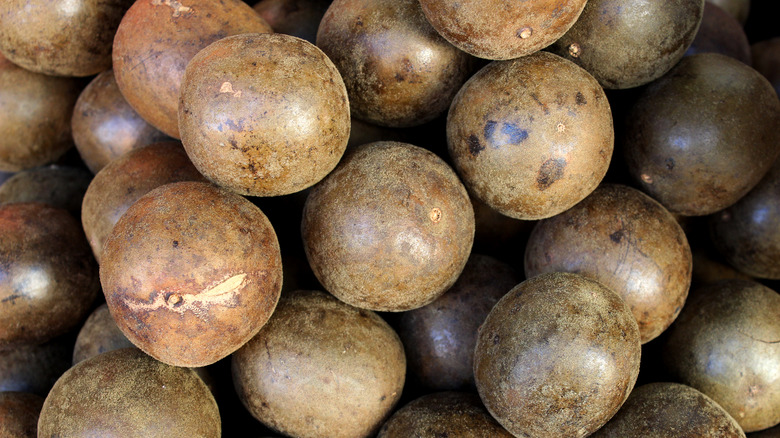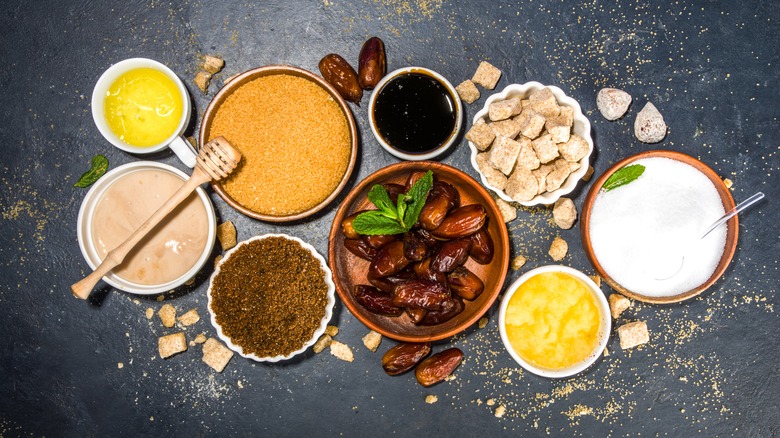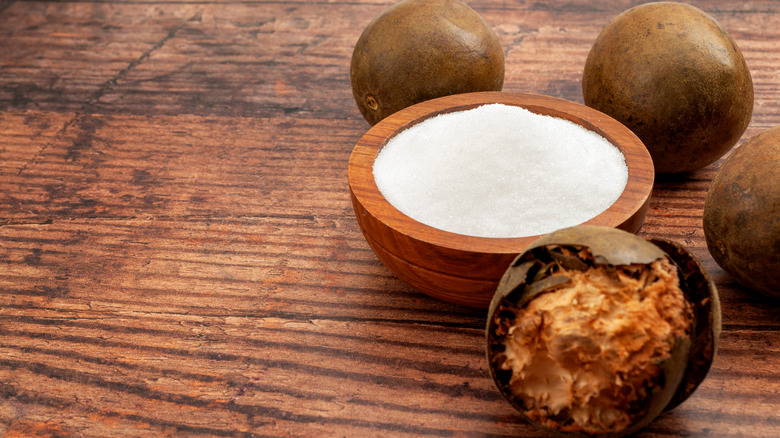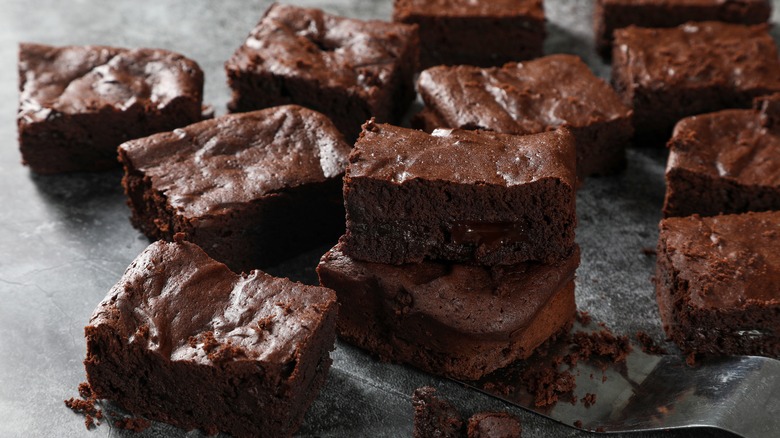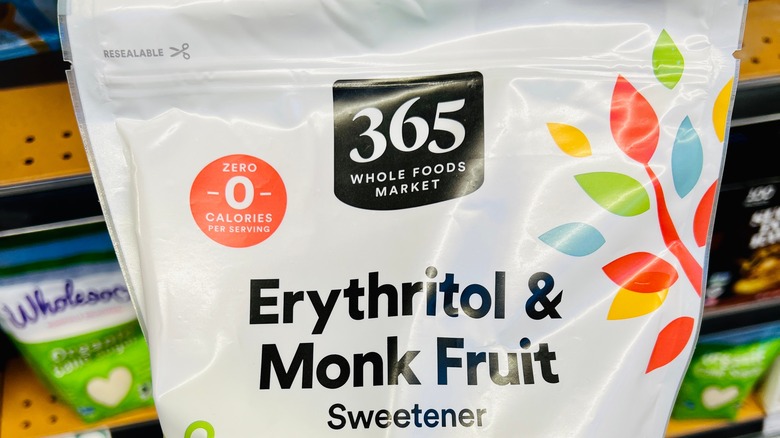Everything You Need To Know About Monk Fruit Sweetener
In the year 2018, the Food and Drug Administration classified extracts from Luo Han Guo (scientific name siraitia grosvenorii) as "generally recognized as safe" (GRAS). More commonly known as monk fruit, the classification allowed companies to process the fruit and incorporate it into powders and extracts as a sugar alternative. Since then, monk fruit sweeteners are all over the place — from chocolate bars to canned coffee drinks.
Despite being used medicinally in southern China for thousands of years (via WebMD), the mystical sweetener is relatively new in the United States. Thus, there are still a lot of unknowns, and a few questions surrounding the fruit remain. Why is it called monk fruit? How does it stand against other sugar substitutes? How do you use it? Consider this the guide to all things monk fruit sweetener, where all of your pressing questions will find answers.
What is monk fruit sweetener?
Monk fruit sweetener is an alternative to sugar that, like other sweeteners, is metabolized differently in your body (via WebMD). Earning its name from the 13th-century Buddhist monks in southern China who originally cultivated it (via Healthline), the small, round, melon-like fruits belong to the same family as gourds. The fruit itself is rather unappealing, ranging in color from brown to green, but a unique treasure is found within that gives it its sweet flavor.
While other gourds, such as pumpkins and cucumbers, aren't considered sweet, monk fruit's high levels of antioxidants are responsible for its unique taste (via Healthline). Monk fruit sweetener is made exclusively from these antioxidants, called mogrosides (the sweetest part of the fruit). After the antioxidants are crushed and extracted from the fruit, they create a sugar alternative up to 250 times sweeter than sugar with no calories, carbs, or fat.
How is monk fruit sweetener made?
Typically, monk fruit sweetener is made in a few steps. The fruit has to be prepared to be juiced, so it's usually skinned and its seeds are removed (via Food Insight). After that, the fruit is crushed to release its juice. Then, the monk fruit juice is mixed with hot water and filtered before moving on to the extraction process (via WebMD). During extraction, the sweet mogrosides are drawn out and either transformed into a liquid (which is used in monk fruit syrup) or dried to create a powder, which is sold as monk fruit sugar (via Cleveland Clinic).
What happens after the extraction process depends on the brand of monk fruit you buy. Because the sweetener is so much sweeter than other types of sugar, some companies blend the mixture with ingredients like erythritol and dextrose, according to Healthline. Not only does blending monk fruit sweetener with these ingredients make it look and feel more like regular table sugar, but they help balance out its intense sweetness.
Monk fruit sweetener vs. stevia
As of now, there is no evidence to show that monk fruit has any adverse side effects, besides being somewhat hard to find at the store (via Healthline). Both stevia and monk fruit sweeteners work as versatile sugar substitutes, and boast a lack of calories, fat, and carbs. But there is one downside to stevia — besides its bitter aftertaste — that could make you consider choosing monk fruit sweetener instead.
The Food and Drug Administration considers the whole leaves from stevia plants unsafe. Whole leaf and crude stevia extracts are banned from use in sweeteners in the United States. As a result, most of the stevia on the market isn't actually stevia; they're mixtures of steviol glycosides. To be sold as a sweetener in the U.S., the FDA requires stevia to be at least 95% refined and purified. While this version of stevia has been classified as GRAS, monk fruit is considered much more natural.
What does monk fruit sweetener taste like?
At up to 250 times sweeter than sugar (via Healthline), it's safe to assume that monk fruit sweetener is, in fact, sweet. Generally, its flavor leans more toward the fruity side. Unlike other alternative sweeteners, Food Network says that monk fruit only has a slight aftertaste. However, sweetness, taste, and texture can range if your monk fruit is blended with other sugars or sweeteners, so be sure to check the ingredient list before purchasing.
Raw monk fruit sweetener will be a light beige color with a coarse, sugar-like texture. Some brands blend the monk fruit sweetener with other alcohol sugars like erythritol to make it look more like sugar (via Food Insight). Dextrose is also commonly added to balance out monk fruit's intense sweetness and make it taste more like regular sugar (via Healthline).
How to cook with monk fruit sweetener
Monk fruit sweetener works great raw — either added in a cup of coffee or sprinkled on top of fruit. Because it can stay stable under high heat (via WebMD), monk fruit sweetener is also an excellent substitute for your favorite recipes. Before you do that, though, there are a few notes you may want to take. Since monk fruit sweetener is much sweeter than regular sugar, you'll most likely want to cut back on whatever amount the recipe calls for. Just remember, if you reduce it by more than 25%, you risk altering the look and texture of your baked treats (via Lakanto).
Sugar plays more roles in baking than just being sweet, so don't expect everything to come out the same as it usually would. Lakanto recommends blending monk fruit sweetener into powder to avoid inconsistencies in texture. They also say that when using a recipe that calls for melted fat, such as butter or coconut oil, you should add monk fruit sweetener to the melted fat. This will allow it to dissolve completely, giving you a more consistent result. Similarly, you'll want to add the monk fruit sweetener to the liquids rather than the dry ingredients when baking.
Where to buy monk fruit sweetener
Monk fruit sweetener can be tricky to find depending on where you shop. However, most food stores carry it. You can find brands like Lakanto and Monk Fruit In The Raw at stores like Walmart, where they sell several varieties — including baking, blended, and unblended versions. If you're shopping in person, you'll typically want to look in the baking aisle. Usually, the monk fruit sweeteners are located right next to the other sugar alternatives. Sometimes, if you look where the maple and agave syrups are, you can also find monk fruit syrup. If you can't find any there, your next best bet is the health food aisle.
If you're not into shopping in person, which Forbes says has been a common shift since the COVID-19 pandemic, you can also find monk fruit sweeteners online. Whether you prefer Amazon, Target, or Instacart delivery, you can get good quality monk fruit sweeteners delivered right to your door without having to leave your couch. Just don't forget to check the ingredient list. Sometimes monk fruit sweeteners are blended with other sugar alcohols, which could affect the nutrition content (via Healthline).
Monk fruit nutritional information
As a sweetener, monk fruit has many benefits compared to sugar. Not only do you not have to worry about your dental costs when using it (via WebMD), but a 2011 study found that the mogrosides that monk fruit is made from have anti-inflammatory properties. Additionally, another 2013 study found that mogrosides could help reduce oxidative stress, which leads to diseases like cancer, Alzheimer's, Parkinson's, and more (via Medical News Today). However, its main benefit, and why it's used by many, is its role in improving glycemic control.
According to Food Insight, only minor amounts of monk fruit sweetener are absorbed into the bloodstream, making it safe for people with diabetes. Raw monk fruit sweetener without any additives is sugar-free, and doesn't have any carbs, calories, or fats — making it a helpful option for people who want to lose weight, according to WebMD. However, some brands can include additives that alter the nutrition profile. For this reason, those monitoring their insulin activity should be wary and check the ingredients before purchasing a monk fruit sweetener.
Other varieties of monk fruit sweetener
Monk fruit sweetener comes in a few different varieties: monk fruit sugar, monk fruit syrup, and monk fruit powder. Generally, each of these is used in the same way: as an alternative, sugar-free sweetener that is used as a sugar substitution. While each variety is interchangeable, some are better used as a substitute for specific things. For example, monk fruit syrup is best for maple syrup or other liquid sweeteners in recipes that don't require sugar for anything other than sweetening. Monk fruit sugar is best for substituting traditional table sugar, and monk fruit powder is best as a substitution for confectioners' sugar (via What Sugar Blog).
Other varieties can appear from brand to brand. In addition to pure monk fruit sweeteners and extracts, which are best for sweetening purposes only (and not preferred for baking or culinary purposes), brands carry versions blended with additives. You'll find a bunch of monk fruit sweeteners with packaging that says it either includes or is free from erythritol, allulose, stevia, glucose, maltodextrin, tagatose, inulin, or some combination of multiple of these ingredients on their labels. These additives make the monk fruit sweetener taste and look more like sugar and alter it for different culinary purposes. However, some of these can add calories to the monk fruit.
